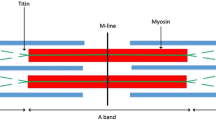Summary
A mathematical model incorporating Huxley's sliding filament crossbridge muscle model coupled with parallel and series elastic components was simulated to examine force-length relations under different external calcium concentrations. Several researchers have determined experimentally in both papillary muscle preparations and in situ heart experiments that the calcium concentration (or effective concentration from inotropic agents) will affect the strength and convexity of the cardiac muscle fiber force-length relations. Simulations were performed over a several-order-of-magnitude range of calcium concentrations in isometric contractions and these showed that the force-length curve convexity was changed. Simulation results demonstrated that increasing the stiffness in the model contractile element or series elasticity element did not change the force-length convexity. Increasing the series elasticity element stiffness did slightly change the shape of the force-length curve. The model predicts that the curve convexity changes as a result of the calcium-troponin interactions.
Similar content being viewed by others
References
Suga H (1990) Ventricular energetics. Physiol Rev 70:247–277
Jewell BR (1977) A re-examination of the influence of muscle length on myocardial performance. Circ Res 40:221–230
Lakatta EG, Henderson AH (1977) Starling's Law reactivated. J Mol Cell Cardiol 9:347–351
Ter Keurs HEDJ, Rijnsburger WH, Van Heuningen R, Nagelsmit MJ (1980) Tension development and sarcomere length in rat cardiac trabeculae. Evidence of length-dependent activation. Circ Res 46:703–714
Allen DG, Kentish JC (1985) The cellular basis of the length-tension relation in cardiac muscle. J Mol Cell Cardiol 17:821–840
Burkhoff D, Sugiura S, Yue D, Sagawa K (1987) Contractility dependent curvilinearity of end-systolic pressure-volume relations. Am J Physiol 252 (Heart Circ. Physiol. 21):H1218–H1227
Wong AYK (1971) Mechanics of cardiac muscle, based on Huxley's Model: mathematical simulation of isometric contraction. J Biomech 4:529–540
Wong AYK (1972) Mechanics of cardiac muscle, based on Huxley's Model: simulation of active state and force-velocity relation. J Biomech 5:107–117
Wong AYK (1973) Some proposals in cardiac muscle mechanics and energetics. Bull Math Biol 35:375–399
Wong AYK (1974) Application of Huxley's sliding-filament theory to the mechanics of normal and hypertrophied cardiac muscle. In: Mirsky I, Ghista DN, Sandler H (eds) Cardiac mechanics: physiological, clinical, and mathematical considerations. John Wiley, New York
Huxley AF (1957) Muscle structure and theories of contraction. Prog Biophys Biophys Chem 7:255–318
Panerai RB (1980) A model of cardiac muscle mechanics and energetics. J Biomech 13:929–940
Robertson SP, Johnson JD, Potter JD (1981) The time-course of Ca2+ exchange with calmodulin, troponin, parvalbumin, and myosin in response to transient increases in Ca2+. Biophys J 34:559–569
Taylor TW. Goto Y, Suga H (to be published) Variable crossbridge cycling-ATP coupling accounts for cardiac mechanoenergetics. Am J Physiol
Sonnenblick EH (1962) Implications of muscle mechanics in the heart. Fed Proc Fed Am Socs Exp Biol 21:975–990
Hibberd MG, Jewell BR (1982) Calcium and length-dependent force production in rat ventricular muscle. J Physiol 329:527–540
Author information
Authors and Affiliations
Additional information
On leave from the Yale School of Medicine 367 Cedar St., New Haven, CT 06510 USA
Rights and permissions
About this article
Cite this article
Taylor, T.W., Goto, Y. & Suga, H. Cardiac muscle fiber force versus length determined by a cardiac muscle crossbridge model. Heart Vessels 7, 200–205 (1992). https://doi.org/10.1007/BF01744605
Received:
Revised:
Accepted:
Issue Date:
DOI: https://doi.org/10.1007/BF01744605




